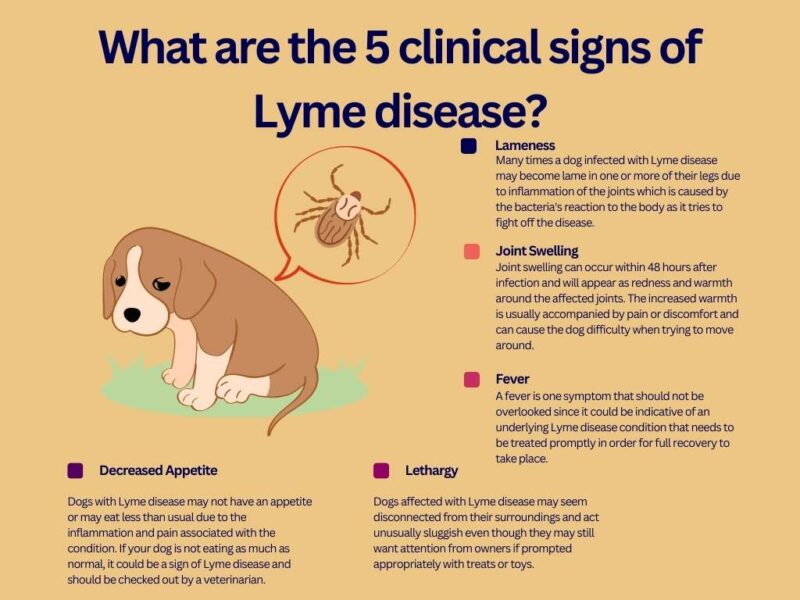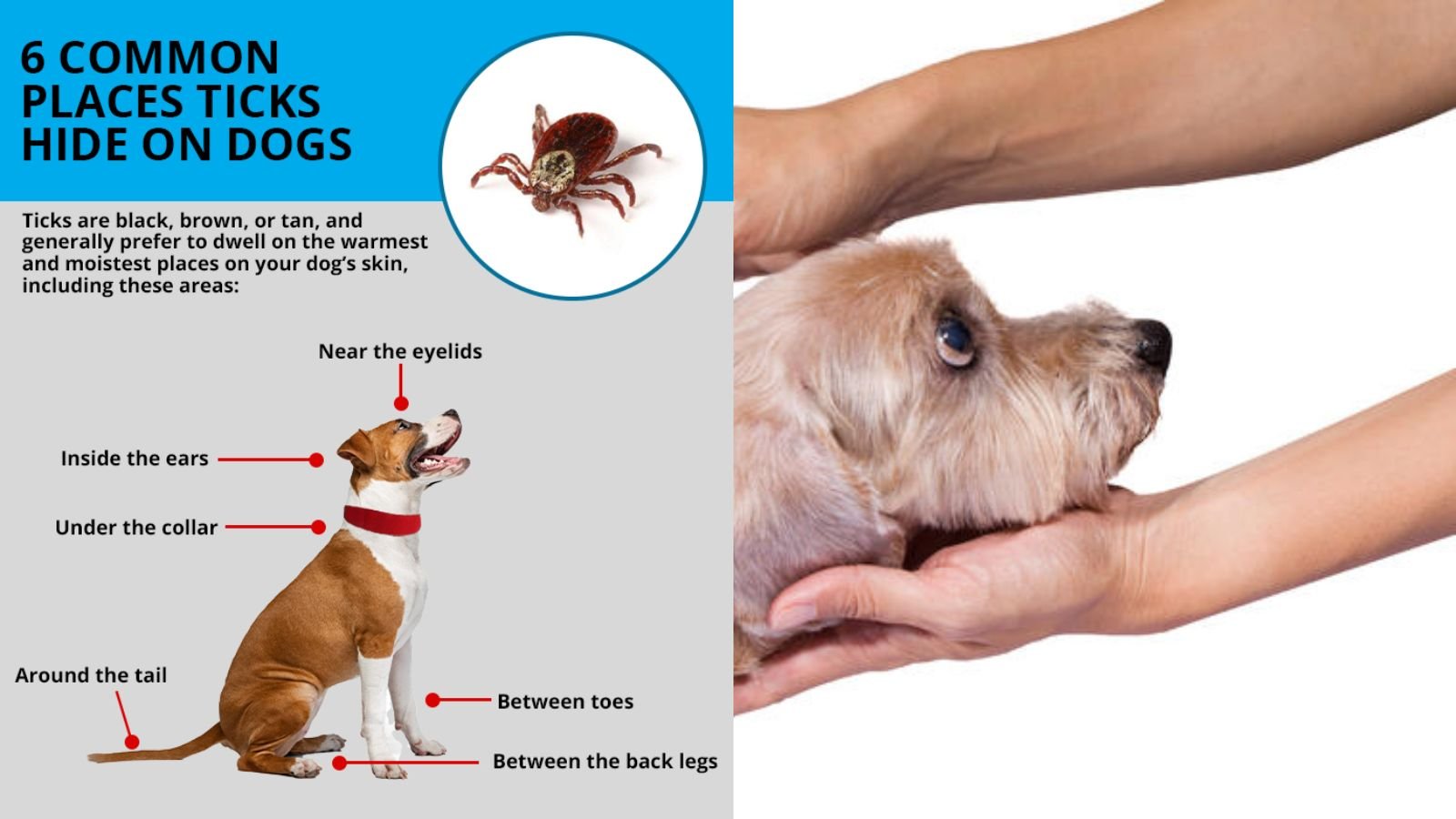Find out How Do I Know If My Dog Has Lyme Disease. To determine if your dog has Lyme disease, look for symptoms like fever, lameness, and joint swelling. Additionally, watch for loss of appetite and lethargy.
It’s crucial to consult a veterinarian for proper diagnosis and treatment. Lyme disease is a serious bacterial infection transmitted through tick bites. Prevention is key, so regularly check your dog for ticks, especially after outdoor activities. Prompt detection and treatment can help your furry friend recover quickly.
Look for any unusual behavior or symptoms that could indicate Lyme disease, and seek veterinary care if needed. Your dog’s health and well-being are top priorities, so stay vigilant and proactive in preventing and managing Lyme disease.

Credit: beyondpets.com
Introduction To Lyme Disease In Dogs
Ticks cause Lyme disease in dogs, which can lead to serious health issues if not treated early. Symptoms can include joint pain, fever, and lethargy. If you suspect your dog may have been exposed to ticks, it is important to visit a veterinarian for testing and treatment.
The Tick-borne Threat
Lyme disease in dogs is a serious concern, especially in regions with prevalent ticks. These tiny parasites can transmit the bacteria Borrelia burgdorferi to dogs through their bites, leading to Lyme disease. As a pet owner, it’s crucial to be aware of the potential dangers posed by these blood-sucking pests.
Importance Of Early Detection
Early detection of Lyme disease in dogs is essential for effective treatment. By recognizing the symptoms and seeking prompt veterinary care, pet owners can prevent the progression of the disease and minimize the potential long-term effects on their furry companions.
Transmission And Risk Factors
Understanding the transmission and risk factors of Lyme disease in dogs is crucial for prevention and early detection. By knowing how the disease spreads and the factors that increase the risk of infection, pet owners can take proactive measures to protect their furry companions.
Ticks As The Primary Vector
Ticks are the primary carriers of Lyme disease, transmitting the bacteria through their bites. The bacteria responsible for Lyme disease, Borrelia burgdorferi, is typically carried by the deer tick, also known as the black-legged tick. When an infected tick attaches to a dog and feeds on its blood, it can transfer the bacteria, leading to potential infection.
High-risk Areas And Seasons
High-risk areas for Lyme disease transmission include regions with dense populations of ticks, such as wooded areas, tall grasses, and brushy environments. High-risk seasons for tick activity and potential transmission occur during the warmer months, particularly spring through fall. These periods coincide with the peak activity of ticks, increasing the likelihood of exposure to infected vectors.
Early Symptoms To Watch For
Fever And Lethargy
One of the early signs of Lyme disease in dogs is a fever accompanied by lethargy. If your dog seems listless and has an unexplained high temperature, it could be a red flag for Lyme disease.
Appetite Loss And Dehydration
Another symptom to watch for is a sudden loss of appetite and increased dehydration. If your furry friend is avoiding food and exhibiting signs of dehydration, it might indicate Lyme disease.

Credit: www.youtube.com
Physical Indicators Of Lyme Disease
Knowing the physical indicators that may suggest your furry friend has been affected by Lyme disease in dogs is crucial. Recognizing these signs early can lead to prompt treatment and a better prognosis for your pet. Here are some key physical indicators of Lyme disease to watch out for.
Joint Swelling And Pain
Dogs with Lyme disease may experience swelling and pain in their joints. This is often most noticeable in the larger joints, such as the knees, causing discomfort and difficulty with movement. Look for any tenderness or inflammation in these areas, as it could be a sign of Lyme disease.
Lameness In Limbs
Lameness in one or more limbs can be a prominent indicator of Lyme disease in dogs. If your dog is limping or showing reluctance to put weight on a particular limb, it could result from the disease affecting their joints. This lameness may come and go, making monitoring your pet’s mobility closely essential.
Behavioral Changes In Affected Dogs
Behavioral changes in dogs can be a key indicator of Lyme disease. Recognizing these changes can help pet owners seek prompt veterinary care and improve their dog’s chances of recovery. Several behavioral shifts may occur in dogs affected by Lyme disease, including unusual aggression and signs of depression.
Unusual Aggression
Dogs with Lyme disease may exhibit unusual aggression towards humans or other animals. This can manifest as growling, snapping, or biting, especially in response to minor triggers. Pet owners must recognize that this behavior is out of character for their dog and seek veterinary attention promptly.
Signs Of Depression
Signs of depression in dogs with Lyme disease can include lethargy, decreased interest in activities they once enjoyed, and withdrawal from social interaction. Additionally, affected dogs may display changes in appetite and sleep patterns. These behavioral changes can be distressing for pet owners, underscoring the importance of seeking veterinary care to address the underlying medical condition.
Long-term Health Complications
Detecting Lyme disease in dogs is crucial to prevent long-term health issues. Look for symptoms like lethargy, joint swelling, and fever. Consult a vet promptly for diagnosis and treatment.
Kidney problems
Lyme disease in dogs can lead to kidney dysfunction if left untreated.
Heart and nervous system issues
Heart rhythm abnormalities and nervous system disorders are potential long-term effects of Lyme disease in dogs.
Regular monitoring and early treatment are crucial to prevent severe complications.
Diagnosis And Testing
Diagnosing Lyme disease in dogs involves a combination of clinical signs, veterinary examination, and specific blood tests. Early detection and treatment are crucial in managing the disease and preventing long-term complications. Here’s an overview of the diagnostic process for Lyme disease in dogs.
Blood Tests And Their Interpretations
Blood tests play a key role in diagnosing Lyme disease in dogs. The most common test is the C6 peptide test, which detects antibodies against the bacteria that cause Lyme disease. A positive result indicates exposure to the bacteria, while a negative result suggests no exposure or an early infection. Quantitative C6 testing can provide additional information about the level of exposure and help assess the response to treatment.
The Role Of Veterinary Examination
A thorough veterinary examination is essential in diagnosing Lyme disease. The veterinarian will assess the dog’s clinical signs, including lameness, joint pain, and fever. Joint palpation and limb manipulation can help identify areas of discomfort and inflammation. Additionally, the vet will look for evidence of tick exposure and may perform additional tests to rule out other diseases with similar symptoms.

Credit: www.mypawsitivepals.com
Treatment Options And Prevention
When it comes to Lyme disease in dogs, early detection and prompt treatment are crucial. Understanding the treatment options and prevention strategies can help keep your furry friend safe and healthy.
Antibiotic Treatments
Antibiotic treatments are the primary course of action for dogs diagnosed with Lyme disease. Commonly prescribed antibiotics such as doxycycline or amoxicillin can effectively eliminate the infection. Administering the full course of antibiotics as the veterinarian directs is essential to eradicate the bacteria.
Vaccines And Tick Prevention Strategies
Vaccines and tick prevention strategies are vital in safeguarding your dog against Lyme disease. Vaccination against Lyme disease is available and beneficial, especially for dogs residing in high-risk areas. Implementing tick prevention strategies such as regular tick checks, using tick repellents, and maintaining a well-groomed environment can significantly reduce the risk of Lyme disease transmission.
Ongoing Care And Management
When it comes to ongoing care and managing a dog with Lyme disease, it’s crucial to focus on Diet and nutrition and Regular health check-ups to ensure their well-being.
Diet And Nutrition
- Provide a balanced diet rich in essential nutrients to boost the immune system.
- Include omega-3 fatty acids to help reduce inflammation and support joint health.
- Limit treats high in sugar as they can worsen symptoms.
Regular Health Check-ups
- Schedule routine vet visits for early detection and monitoring of Lyme disease.
- Ensure your dog receives regular tick prevention treatments to avoid re-infection.
- Monitor for any changes in behavior or symptoms and report to the vet promptly.
Frequently Asked Questions
How Do I Know If My Dog Has Lyme Disease?
To determine if your dog has Lyme disease, look for symptoms like fever, lameness, and joint swelling. Additionally, watch for loss of appetite and lethargy.
How Do You Detect Lyme Disease In Dogs?
Lyme disease in dogs is detected through blood tests, clinical signs, and tick exposure history. Early detection is crucial for effective treatment.
Is Lyme Disease Curable In Dogs?
Yes, Lyme disease is curable in dogs. Early diagnosis and treatment with antibiotics can effectively cure the disease. However, if left untreated, it can lead to severe health complications. Regular tick prevention measures can also help in preventing the disease.
What Are The Three Stages Of Lyme Disease In Dogs?
The three stages of Lyme disease in dogs are early localized, early disseminated, and late disseminated.
How Long After A Tick Bite Does A Dog Get Lyme Disease?
A dog can get Lyme disease 24 to 48 hours after a tick bite. Regular tick checks and preventive measures are crucial.
Conclusion
Lyme disease is a serious ailment that can devastate your furry friend. If you suspect your dog may have contracted the disease, it is important to watch for the symptoms and take immediate action.
By taking proactive preventative measures, such as tick control and regular vet check-ups, you can help ensure your dog stays happy and healthy for years. Remember, early detection is key to Lyme disease, so don’t hesitate to seek medical attention if you have any concerns about your dog’s health.

Hello I am Farhana I have been doing research on dogs since last 10 years. I have been doing research on dog special parts or dog food since last 10 years. I have gained knowledge about my dog in these ten years so. I want to blog about it daily.

